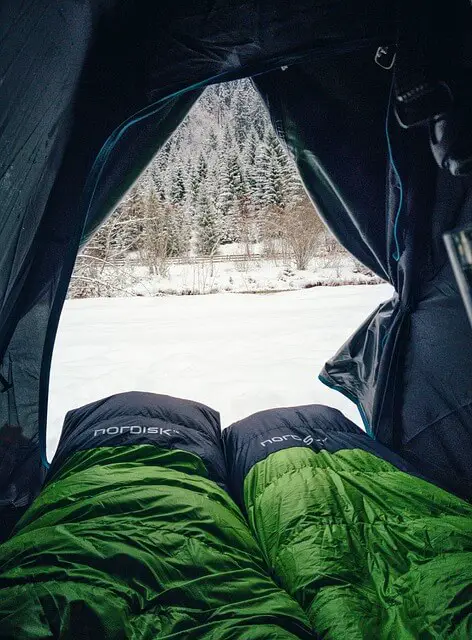Camping and hiking are not activities that are limited to warm weather. Many hikers and campers choose to enjoy the peacefulness of autumn and winter when the leaves are in all different colors or when the snow makes everything look like a fairytale. Even though camping in that kind of weather is fantastic, it is also a bit challenging, especially when it comes to staying warm.
There is the option to stay in cabins or rent apartments when the weather becomes too cold to camp, but there are extreme campers who want to stay in tents even in cold weather. If you fall into the latter category, I have a few tips and tricks that you can use to make your tent warmer.
Using my tips, you can increase the warmth of your tent’s inside and stay warm and protected during your trips. If this all sounds interesting to you and you want to learn more about it, I recommend you keep reading!
More...

How to Make a Tent Warmer - 6 Simple Steps
Making a tent warmer is different than keeping yourself warm. You can try layering your clothes and wearing heated gloves, socks, or beanies to keep your body warm during a camping trip. You can even try doing a few tricks with your sleeping bag, such as adding hot water bottles to it or an extra blanket over or inside it.
These tips are great for keeping your body warm but will not make the actual tent warmer. To warm your tent, you will need to focus on other suggestions like those on the list below. So, let’s go over them and talk about each one in greater detail:
Step 1 – Choose a good location
You will not be able to make your tent warmer if it is exposed to the cold winds of autumn or winter. Choosing a good location for your tent is crucial throughout the year, but it is vital in cold weather. You will need to do your best to find a suitable place that will help you keep your tent warmer than usual.
For example, try to find an area with direct sunlight throughout the day but also surrounded by trees. The sun will help heat the tent during the day, whereas the trees surrounding it will block the wind. Then, there will be a lesser chance of the tent becoming colder during the night because it will not be exposed to wind.
Try to set your tent away from water when camping in cold temperatures. While water is crucial in any camping season, it is better to stay far away during winter because any area close to water is generally colder. You can feel the wind more as you approach an area with a stream nearby, so try to stay away from that area to keep your tent warmer.
Step 2 – Use ground insulation
In cold weather, it is expected for the ground to be colder than usual. If you try to put your hand on it, it will feel cold to the touch. So, you should expect that placing your tent directly on the ground will expose it and everyone in it to coldness.
To be successful at keeping your tent warm, you will need to add some ground insulation under your tent. I would recommend that you always put a layer between the ground and your tent as a precautionary measure so as not to damage the bottom of the tent. While you can use a regular tarp throughout the year, you should consider adding something warmer during winter.
You can use a wooden platform that you make out of flat boards or logs, and a blanket or insulation foam. If you do not have access to these things, you can also take an extra warm blanket with you and place it under the tent before setting it up. Blankets are not that heavy and are easy to transport, so this is a good option if you are hiking to your campsite.

Step 3 – Set a tarp or rainfly over the tent
If you have a tent with the insulated ground, you might not need to add an extra layer between it and the actual ground. In that case, you can add an extra layer on top of the tent to prevent cold air from getting in through the walls.
I recommend you do this by adding a tarp or rainfly over the tent. Most modern tents come with at least one of the two options included with the tent, but there is a catch. To use the tarp or rainfly as protection against cold, they need to be the size of the tent and be able to cover the tent.
Try to measure your tarp or rainfly against the tent at home and see if one can cover the entire tent. If not, consider investing in an extra tarp to cover the tent. Then, when you need protection on a cold night, you can throw the tarp on top of the tent and be good to go. It is that simple!
Step 4 – Use a layer of insulation over the tent
This tip is connected to the previous one, so you can do them in combination or separately, depending on your preference. When you want to feel warm in your tent but the weather outside is too cold, you will sometimes need a few layers of insulation to get the desired warmth.
Sometimes, it helps to have a quality tent and temperature-rated sleeping bag. Still, you can also add insulation to make the tent warmer. I mentioned that you could add a tarp or rainfly over it, but you can also add an insulation layer between the tent and the tarp for extra warmth.
That extra layer of insulation can be anything from regular material to a blanket, foam pads, or even newspaper. You can work with anything that you have at your disposal. But since you might not be able to find such things at your campsite, you need to remember to take them from home. Then, please do your best to take them back and not leave them as trash on the campsite.
Step 5 – Allow constant airflow
You do need to allow constant airflow even when cold weather is camping. If you do not do this, the warmth will cause condensation inside the tent, and the condensation will trap the heat.
To stay warm, please do your best to have constant airflow even when in the tent. This is because you can cause more condensation to form even by breathing. So, keep a small opening on top of the tent or the side, or try to keep the door open at all times.
Another thing to remember is not to keep anything wet inside the tent, as that might lead to more condensation. If you have wet clothes or your shoes are wet, keep them outside of your tent. Do not let anything inside the tent that will contribute to condensation, even warm fluids.
Step 6 – Use a tent heater
Relying on a campfire when camping in the cold is not that convenient because you will have to stay in the cold, overlooking the fire. Leaving the campfire going while you sleep is also not a good idea, so you should find something more convenient that will keep you warm.
For example, you can invest in a portable tent heater that works with propane cans. The cans are relatively inexpensive and easy to transport, but so is the heater.
Still, it would help if you remembered to keep the tent ventilated as the fumes from the heater can cause you some problems. So, keep an eye on the heater and take action if you feel something is wrong with the propane cans.

Wrap-Up
That is all you need to know on how to make your tent warmer when camping in cold weather. Remember that you can use insulation outside your tent to make it warmer inside. In contrast, you can also use a heater or something inside the tent to make the inside warmer.
Try out all the things mentioned in the guide and find the one that works best for you. Then, remember to share in the comments what helped you warm your tent the most and what you would recommend to other campers.
- Are Merrell Shoes Good? – An Unbiased Review of Merrell Footwear - December 9, 2023
- Where Are Merrell Shoes Made? - December 9, 2023
- Camping in 40-degree Weather: Tips and Tricks - September 25, 2023

![Are Mittens Warmer Than Gloves? [Quick Answers You Should Know] Are Mittens Warmer Than Gloves? [Quick Answers You Should Know]](https://grandcircletrails.com/wp-content/uploads/2021/11/hiking-glooves-1-150x150.jpg)
![Is Merino Wool Warmer Than Regular Wool? [Explained] Is Merino Wool Warmer Than Regular Wool? [Explained]](https://grandcircletrails.com/wp-content/uploads/2022/02/Is-Merino-Wool-Warmer-Than-Regular-Wool-150x150.jpg)
![Is Camping Safe or Dangerous? [Few Simple Safety Tips] Is Camping Safe or Dangerous? [Few Simple Safety Tips]](https://grandcircletrails.com/wp-content/uploads/2022/05/Is-Camping-Safe-or-Dangerous-150x150.jpg)
![How To Cook Rice When Camping? [12 Easy Ways] How To Cook Rice When Camping? [12 Easy Ways]](https://grandcircletrails.com/wp-content/uploads/2022/10/How-To-Cook-Rice-When-Camping-150x150.jpg)

![How to Stay Warm Sleeping in a Car? [Detailed Guide & Tips] How to Stay Warm Sleeping in a Car? [Detailed Guide & Tips]](https://grandcircletrails.com/wp-content/uploads/2021/10/How-to-Stay-Warm-Sleeping-in-a-Car-1-150x150.jpg)